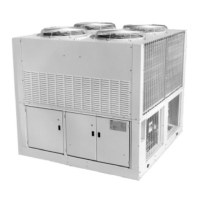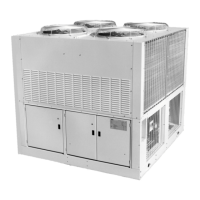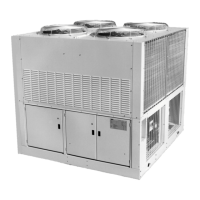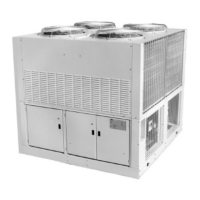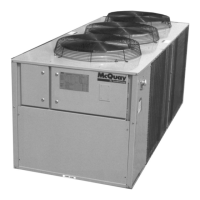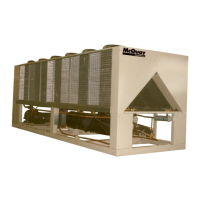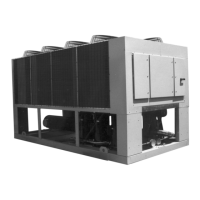Product Manual AGR-3 AGR 070A through 100A
11
Packaged Chiller, Model AS, R-134a
NOTE: R-134a performance is not ARI Certified
AGR performance with R-134a refrigerant is calculated from the R-22 ratings as follows:
1)
Calculate the unit R-134a capacity;
multiply the R-22 capacity by 0.68.
2)
Calculate the unit R-134a power input;
a)
Calculate the unit R-22 power (kW shown in tables is compressor only);
EERUnit
xTonsR
kWUnitR
12022
22
−
=
b)
Calculate the unit fan and control power (unaffected by refrigerant);
TablefromkWCompressorRkWUnitRkWControlFan
2222/
−=
c)
Calculate the R-134a compressor power;
multiply the R-22 compressor kW by 0.615
d)
Calculate the unit R-134a kW;
fan & control power from b)+R-134a compressor power c)
3)
Calculate R-134a EER:
kWUnitaR
MBHcapacityaR
EERaR
134
134
134
=
Remote Evaporator, Model AM
Selection with Inch-Pound (I-P) units
Since the AGR-AM units always include a specific remote shell-and-tube evaporator,
the ratings are based on leaving chilled water temperature and ambient air temperature
from the Rating Tables corrected for line loss as follows.
Table 9 (Inch-Pound units) and Table 10 (SI units) cover the normal range of leaving evaporator water
temperatures and outside ambient air temperatures. The tables are based on a 10°F (5
°
C) temperature
drop through the evaporator. Adjustment factors for applications having other than a 10°F (5
°
C) drop
can be found in Table 3. The minimum leaving chilled water temperature setpoint without glycol is
42°F (5.6
°
C). For brine selections, see Table 1 for ethylene Table 2 for propylene glycol adjustment
factors. Ratings are based on a 0.0001 (0.0176) fouling factor in the evaporator at sea level operation.
For other fouling factors, derates for different delta-Ts, or altitude correction factors, see Table 3. For
applications outside the catalog ratings contact your local McQuay sales representative.
The length and configuration of the interconnecting refrigerant piping will affect the system capacity.
Derates based on equivalent length of pipe are given in Table 8. Refer to Application Data, Refrigerant
Piping section for guidelines.
The steps for selecting an AGR-AM are as follows:
1.
Add 3% to the required cooling capacity (to approximate correction factors) and make a
preliminary unit selection from performance Table 9 or Table 10.
2.
Divide the required capacity by the appropriate capacity correction factors: glycols from Table 1 or
Table 2; altitude, chilled water Delta T, or fouling factor Table 3; and refrigerant piping derate from
Table 8 as explained in step 3 below.
3.
Determine the suction line size by summing the equivalent feet (from Table 4) of all the fittings
(use a sketch of the piping layout) and
adding the sum of these fitting losses
to the actual linear feet
of tubing. This will then equal the
total equivalent feet
. (To use the equivalent feet, start with the
unit suction connection size from Table 6 as the first try). Knowing the equivalent feet and the unit
size, check the line selection in Table 6 or Table 7 and correct if required.
4.
If the unit rated capacity in the tables is less than the corrected required capacity, redo the selection
with the next larger unit. In most cases the line size will be the unit connection size. If the
selection is satisfactory, correct the power (if applicable) and determine water pressure drop.
